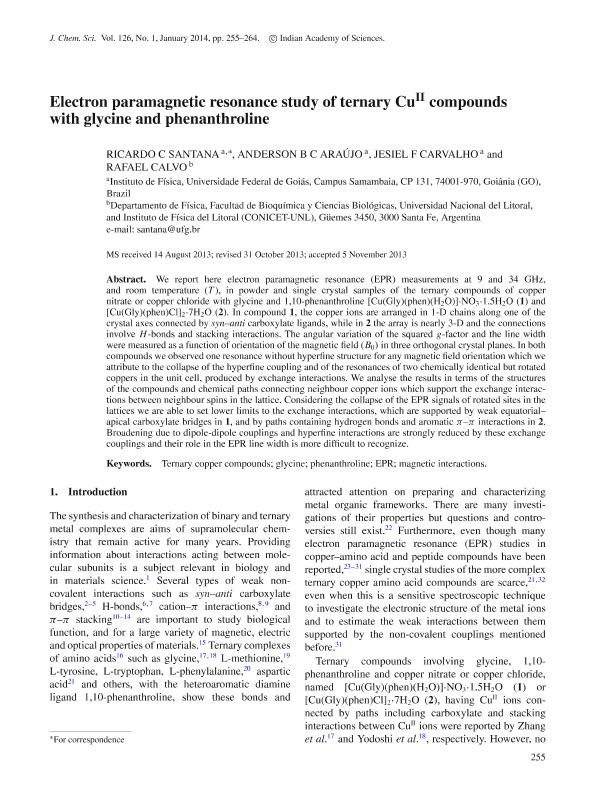Mostrar el registro sencillo del ítem
dc.contributor.author
Santana, Ricardo C.
dc.contributor.author
Araújo, Anderson B. C.
dc.contributor.author
Carvalho, Jesiel F.
dc.contributor.author
Calvo, Rafael

dc.date.available
2016-02-23T18:40:14Z
dc.date.issued
2014-01
dc.identifier.citation
Santana, Ricardo C.; Araújo, Anderson B. C.; Carvalho, Jesiel F.; Calvo, Rafael; Electron Paramagnetic Resonance Study of Ternary CuII Compounds with Glycine and Phenanthroline; Springer; Journal of Chemical Sciences; 126; 1; 1-2014; 255-264
dc.identifier.issn
0974-3626
dc.identifier.uri
http://hdl.handle.net/11336/4407
dc.description.abstract
We report electron paramagnetic resonance (EPR) measurements at 9 and 34 GHz, and room temperature (T), in powder and single crystal samples of the ternary compounds of copper nitrate or copper chloride with glycine and 1,10-phenanthroline [Cu(Gly)(phen)(H2O)]∙NO3∙1.5H2O (1) and [Cu(Gly)(phen)Cl]2∙7H2O (2). In compound 1 the copper ions are arranged in 1-D chains along one of the crystal axes connected by syn-anti carboxylate ligands, while in 2 the array is nearly 3-D and the connections involve H-bonds and stacking interactions. The angular variation of the squared g-factor and the line width were measured as a function of orientation of the magnetic field (B0) in three orthogonal crystal planes. In both compounds we observed one resonance without hyperfine structure for any magnetic field orientation which we attribute to the collapse of the hyperfine coupling and of the resonances of two chemically identical but rotated coppers in the unit cell, produced by exchange interactions. We analyze the results in terms of the structures of the compounds and of the chemical paths connecting neighbor copper ions which support the exchange interactions between neighbor spins in the lattice. Considering the collapse of the EPR signals of rotated sites in the lattices we are able to set lower limits to the exchange interactions, which are supported by weak equatorial-apical carboxylate bridges in 1, and by paths containing hydrogen bonds and aromatic interactions in 2. Broadening due to dipole dipole couplings and hyperfine interactions are strongly reduced by these exchange couplings and their role in the EPR line width is more difficult to recognize.
dc.format
application/pdf
dc.language.iso
eng
dc.publisher
Springer

dc.rights
info:eu-repo/semantics/openAccess
dc.rights.uri
https://creativecommons.org/licenses/by-nc-sa/2.5/ar/
dc.subject
Ternary Copper Compounds
dc.subject
Epr
dc.subject
Glycine
dc.subject
Magnetic Interactions
dc.subject.classification
Química Inorgánica y Nuclear

dc.subject.classification
Ciencias Químicas

dc.subject.classification
CIENCIAS NATURALES Y EXACTAS

dc.title
Electron Paramagnetic Resonance Study of Ternary CuII Compounds with Glycine and Phenanthroline
dc.type
info:eu-repo/semantics/article
dc.type
info:ar-repo/semantics/artículo
dc.type
info:eu-repo/semantics/publishedVersion
dc.date.updated
2016-03-30 10:35:44.97925-03
dc.journal.volume
126
dc.journal.number
1
dc.journal.pagination
255-264
dc.journal.pais
India

dc.journal.ciudad
Bangalore
dc.description.fil
Fil: Santana, Ricardo C.. Universidade Federal de Goias; Brasil
dc.description.fil
Fil: Araújo, Anderson B. C.. Universidade Federal de Goias; Brasil
dc.description.fil
Fil: Carvalho, Jesiel F.. Universidade Federal de Goias; Brasil
dc.description.fil
Fil: Calvo, Rafael. Consejo Nacional de Investigaciones Científicas y Técnicas. Centro Científico Tecnológico Santa Fe. Instituto de Física del Litoral; Argentina. Universidad Nacional del Litoral. Facultad de Bioquímica y Ciencias Biológicas. Departamento de Física; Argentina
dc.journal.title
Journal of Chemical Sciences
dc.relation.alternativeid
info:eu-repo/semantics/altIdentifier/url/http://link.springer.com/article/10.1007/s12039-013-0553-0
dc.relation.alternativeid
info:eu-repo/semantics/altIdentifier/doi/http://dx.doi.org/10.1007/s12039-013-0553-0
dc.relation.alternativeid
info:eu-repo/semantics/altIdentifier/issn/0974-3626
Archivos asociados
